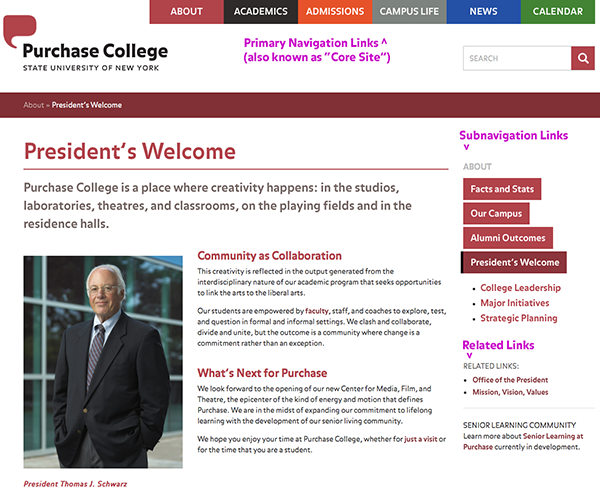Information Architecture
A website’s information architecture (IA) refers to the structure of the site.
It shows where pages exist in relation to each other, what pages have sub-pages, etc.
You see the IA expressed as the site’s main navigation links. The term navigation most often refers to those primary links, but it also refers to other means of moving around the site, such as the list of links on the right side of each page throughout the Purchase College site, often referred to as the “sub-navigation” links. Some pages also offer a list of “Related Links” below the sub-navigation.

Pages on your site should be organized in a way that meets your primary audiences’ expectations while achieving your own goals.
Best Practices
Try to keep your navigation lists under control
Try to keep navigation lists to about 6-8 links in length, and try to avoid more than 8-10. Why? Long lists of links are simply more difficult to scan than short lists, and many links are often more appropriately nested.
Develop a hierarchy of information, nesting some pages under others (as sub-pages) in the structure. Not all pages
can or should be accessible from the main page. The content, navigation, and other links on a page should guide visitors to information deeper in the site.
Use easily identified, descriptive words for IA link titles and avoid “insider-speak”
Categorize and convey information in language that does not require special knowledge of your organization’s acronyms, internal jargon, or office names. Does your navigation contain specific names of offices, initiatives, or events? Work to generalize those titles to make them more understandable to outsiders. Don’t leave your web visitors guessing which page deals with a certain issue. One exception: branded programs and facilities might be required to be listed by name.
Organize your IA to meet audience expectations, not a reflection of the organizational chart
People with no special knowledge of your institutional structures should be able to navigate your site easily.
With the exception of people on campus, most coming to your site will not know the internal administrative or academic organization of Purchase.
Order links based on use, with room for strategic organization
If pages correspond to steps in a process—and should be viewed in succession—list them in that order.
Group pages with related content together.
Don’t let politics rule your link order. Remember: it’s not for you; it’s for the people visiting your site. Revise the navigation list to reflect your primary users’ needs, but balance this with internal knowledge of what you’d like people to see first (your
strategic goals). Alphabetical lists should only be used if the links all have the same level of importance.
Typically, general “About Us” pages should appear first, and “Contact Us” pages last.
Tell a story with your navigation
The pages in your top-level navigation should work together to present the key aspects of your office/program/area.
Users will frequently click through all top-level links one after the other, so they ought to work together to give a sense, however abbreviated, of the overall content to be found throughout the site.
Link only to pages within the section
With few exceptions, your navigation links should lead to internal sub-pages only and not to another site or a pdf (or other) downloadable file.
Links that lead elsewhere or to a download should be incorporated as links in the text and/or as part of a call-out set of Related Links.
On occasion, cross-listing pages in two places is acceptable when the page should clearly be in both.
Stop and think before adding a new page
When someone has information to be “put on the website,” it’s easy to create a new page. But a few questions ought to be asked first:
- Is this an event or news? If yes, it should not be a page. Enter this information into the CMS appropriately so it can be shared throughout the site. The exception is for annual or larger events that require a mini-site to contain all related event information.
- Does this information exist elsewhere on the site? And related, is someone else more directly in charge of this content? If the answer is yes, then briefly mention the info and link to the existing page. This will cut down on redundant and out-of-date information and require less work in the end.
- Is the information seasonal? Could it replace current page content for a time and be swapped out as other information becomes more important?
- Is this information that should exist in one place on the site and won’t change frequently? If the answer is yes, then it’s likely worthy of a page.